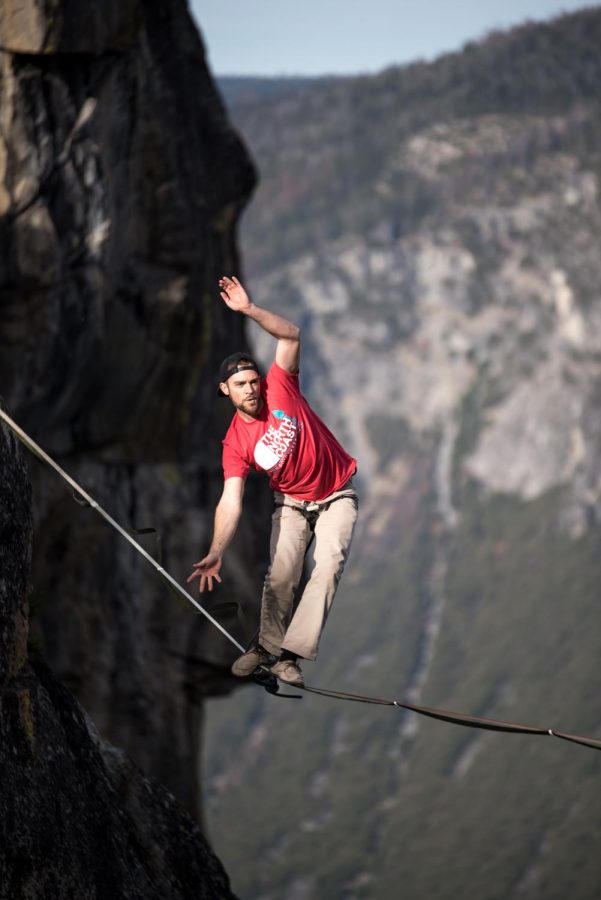Absurd Athletics
Meet tight rope walking’s even more sketchy cousin: slacklining.
Photo by Casey Horner, Submitted
Slacklining’s most dangerous subsection; highlining.
Most are probably familiar with funambulism, the popular stunt event more commonly known as tight rope walking. Due to its popularity as a circus stunt and headline grabbing events like Philippe Petit’s famous high-wire walk between the Twin Towers, tight rope walking has held a familiar place in pop culture for decades.
However, some may not be aware of funambulism’s odd, hippie cousin: slacklining.
Tightrope walking has many forms and dates back centuries, but in general it consists of crossing an elevated gap on a tightly strung wire, using your sense of kinesthesis and equilibrium to maintain balance. Generally, it is performed over a safety net or mats when at a low height, with the exception of certain specialists like the aforementioned Mr. Petit.
In contrast, slacklining originated in Yosemite National Park in the 1970s, because if there’s at least one thing California is good for, it’s inventing cool, odd sports (see: skateboarding).
Created as a way to pass the time among Yosemite’s popular climbing community, slacklining consists of the same core ideas as tightrope walking, but replaces the titular “tightrope” with a stretch of slack, one to two inch webbing.
So, rather than walking across a rigid, stiff rope, slackliners perform their stunts on fabric that bounces and wobbles with every movement.
If you’re aware that Yosemite is the location where climber Alex Honnold performed a 3,000 foot ascent of one of the park’s most famous climbing routes without any rope or safety gear, it makes more sense that the Yosemite crowd were the type to take an extreme sport like tightrope walking and somehow make it more sketchy.
Similarly to tightrope walking, there are a few forms of slacklining. The most popular, reasonably, keeps the line only a few feet above ground. Unreasonably, this low-altitude form of slacklining is usually combined with tricks like backflips to become what is called tricklining.
Additionally, another subsection of slacklining is aptly called waterlining. As you can imagine, this form is essentially the same, but above a body of water. This often increases the safety factor of the activity, but makes it more difficult because the motion of the water can throw off the slackliner’s sense of balance.
Probably the most extreme and infamous form of slacklining is referred to as highlining. In this style of the sport, the slackline is stretched between two points high above the ground. Often, this means crossing canyons or ravines hundreds of feet above the ground.
If it helps your palms stop sweating, be aware that most highliners perform with a rubber strap connected to the line strapped to their ankle, like a surfer’s leg rope, or surf leash.
However, there are some who choose to free solo slackline, meaning they leave behind that crucial strap. One can only assume Petit would be proud.
For many slackliners, the sport is a meditative practice bordering on the level of religion. Some practice yoga slacklining, and Andy Lewis, possibly the most famous slackliner, has described highlining as being a method to access a different “state of consciousness.”
Clearly, there’s more than meets the eye in this niche sport. In this ongoing column, we’ll continue diving into the bizarre world of Absurd Athletics.
If slacklining has grabbed your attention, you can try it out at the McPhee Physical Education Center’s top rope climbing wall, where the Environmental Adventure Center has set up a slackline (with mats) for anybody to try out.
Porisch can be reached at porischn7213@uwec.edu.

Nick Porisch is a third-year English student, and this is his fourth semester at The Spectator. Most of the time you can find him just sitting around someplace, potentially writing but usually just sitting. On the rare occasion he’s not sitting around, he might be rock climbing or running. But most likely he’s just sitting somewhere.

